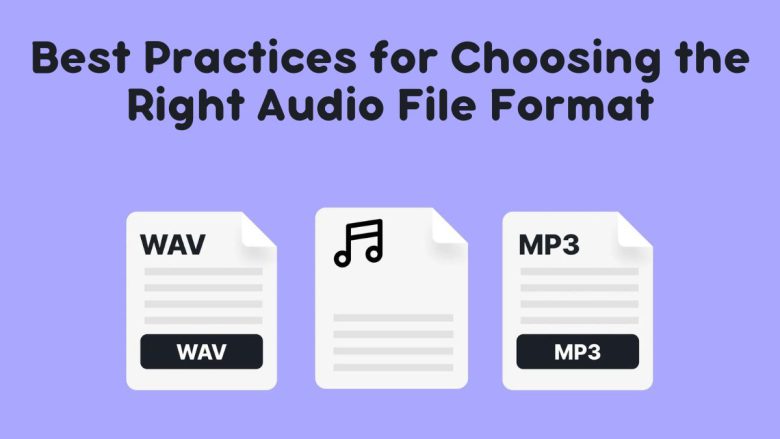
In the digital age, audio files are ubiquitous, from music and podcasts to audiobooks and sound effects. Many audio formats are available. Picking the right one can greatly affect audio quality, compatibility, and usability. This blog post will explore best practices for choosing the right audio file format. The choice should be based on factors like purpose, quality, and distribution.
Understanding Audio File Formats
Before we discuss best practices, you must understand audio file formats. They can generally be categorized into two groups: lossy and lossless.
Lossy Formats
Lossy formats compress audio by removing some data. This makes the files smaller but sacrifices quality. Common lossy formats include:
- MP3: The most popular format for music due to its balance between size and quality.
- AAC (Advanced Audio Codec): Often used for streaming and preferred by platforms like Apple Music for its better quality at lower bit rates.
- OGG Vorbis: An open-source alternative that offers good quality and compression, often used for streaming.
Lossless Formats
Lossless formats keep all audio data. They ensure the best quality but make larger files. Common lossless formats include:
- WAV: Uncompressed and commonly used in professional audio production but results in large file sizes.
- FLAC (Free Lossless Audio Codec): Offers compression without quality loss, ideal for music enthusiasts and archiving.
- AIFF (Audio Interchange File Format): Similar to WAV, often used on Apple systems.
Read Lossless vs. Lossy: Choosing the Right Video Format.
Factors to Consider When Choosing an Audio Format
When selecting an audio format, consider the following factors:
1. Purpose of the Audio
The intended use of the audio file plays a crucial role in determining the best format. Here are some common scenarios:
- Music Distribution: If you’re distributing music online, formats like MP3 or AAC are preferred due to their smaller file sizes and good quality. For high-fidelity audio, FLAC is an excellent choice for audiophiles.
- Podcasting: AAC is favored for podcasts because it offers better quality at lower bit rates, which is essential for streaming. MP3 is also a popular option due to its universal compatibility.
- Professional Audio Editing: If you’re working on music production or audio editing, lossless formats like WAV or AIFF are recommended. They provide the best quality for mixing and mastering.
- Sound Effects and Audio for Video: For sound design and video production, WAV files are often preferred because they are uncompressed and provide the highest fidelity.
2. File Size and Storage
File size matters. This is especially true if you have limited storage space or bandwidth. Lossy formats like MP3 and AAC take up less space and are easier to share online, making them ideal for everyday use. Lossless formats like WAV and FLAC offer better quality. But, they need more storage and can be hard to stream.
3. Compatibility
Compatibility with different devices and software is vital. MP3 is universally compatible with virtually all media players and devices, making it the safest choice for general use. AAC is also widely supported, especially on Apple devices and platforms. However, less common formats like OGG may not be supported by all players. So, it’s essential to ensure that your audience can access your content without problems.
4. Quality Considerations
Quality is paramount, especially for music enthusiasts and professionals. Lossless formats like WAV and FLAC have the best audio quality. They are ideal for archiving and critical listening. But, for casual listening, MP3 and AAC are lossy formats. They can balance size and quality.
5. Streaming vs. Downloading
If your audio will be streamed online. Use a format that balances quality and compression. AAC is often preferred for streaming due to its efficiency. For downloads, you might opt for better formats. This is especially so if your audience values audio quality.
6. Audience and Distribution
Understanding your audience’s preferences can guide your format choice. For example, if your target audience is comprised of casual listeners, MP3 or AAC may suffice. However, if you’re serving audiophiles, offer lossless formats. These include FLAC or WAV.
Best Practices for Audio File Management
You must choose the right format. Also, good audio file management helps your workflow and content distribution.
1. Maintain Original Files
Always keep a copy of the original recordings in a lossless format. This practice ensures that you can always revert to the best version. You can use it for future edits or re-encodings.
2. Organize Your Library
Establish a clear organizational structure for your audio files. Make folders for projects, genres, or use. This will make finding and managing your files easier.
3. Use Metadata
Adding metadata helps your audio files get found and organized. It includes the artist, title, album, and genre. This is especially true for music and podcasts. Most audio editing software allows you to edit metadata easily.
4. Consider File Naming Conventions
Adopting consistent file naming conventions can streamline your workflow. Include relevant information like project name, date, and version number to avoid confusion.
5. Backup Your Files
Regularly back up your audio files to prevent data loss. Use cloud storage or external hard drives. They will keep your content safe.
Conclusion
Picking the right audio format is crucial. It determines the quality, compatibility, and usability of your audio. Consider the purpose of the audio. Also, think about file size, compatibility, and audience needs. Then, you can pick the best format. Remember to use good file management. It will improve your workflow and keep your audio files usable for longer.
Audio content is increasingly consumed on many platforms and devices. In this era, picking good audio formats can greatly improve listening. These best practices will help you deliver high-quality audio. They are for musicians, podcasters, and sound designers. Understand them to tailor your content to your audience’s needs.


